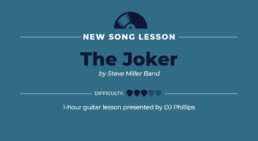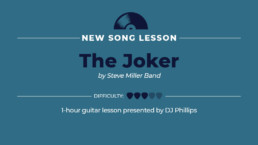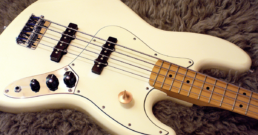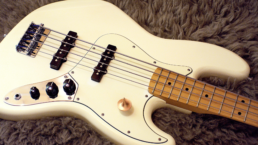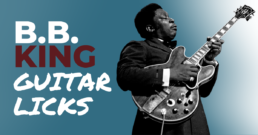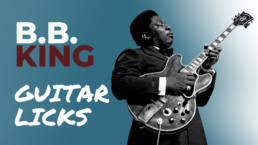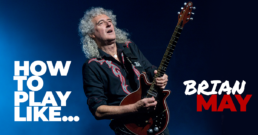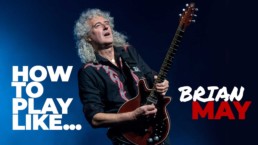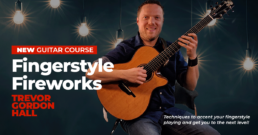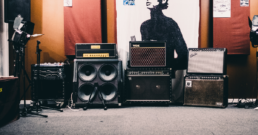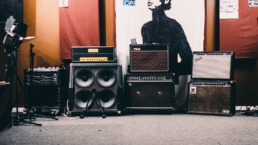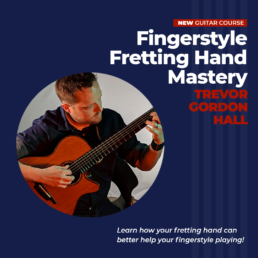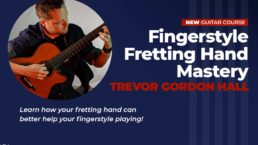Song Lesson: "The Joker" by The Steve Miller Band
In 1966, blues guitarist and singer, Steve Miller left Chicago to start a new band in San Fransisco. The 5-piece group was originally called “The Steve Miller Blues Band,” but they shortened the title to simply “The Steve Miller Band” (a change suggested to the group by Beatles producer, George Martin). Between 1966 and 1972, the band recorded and produced seven studio albums that largely comprised of blues-driven or psychedelic tracks, which collectively garnered moderate levels of acclaim. But in 1973, something magical happened. The Steve Miller Band’s eighth studio album, The Joker, featured a title track that would become the band’s next hit.
Between 1973 and present day, “The Joker,” has topped charts in the US, UK, The Netherlands, New Zealand, and Ireland. The song is certified 5X Platinum in the US, and is undoubtedly The Steve Miller Band’s most popular release to date. And as is the case with many chart-topping hits, the song’s music is relatively simple to play. So, let’s join JamPlay educator, D.J. Phillips in learning how to play “The Joker” by The Steve Miller Band on guitar!
About the Song Lesson:
The guitar parts in “The Joker” consist of two acoustic guitar lines, and one electric guitar line. The acoustic guitars are tuned down a whole step, one with a capo on the third fret. The electric guitar parts are played in an open D tuning, and feature a slide and a wah pedal. In his complete JamPlay song lesson, D.J. Phillips breaks down all three guitar parts accurately, so you can learn how The Steve Miller Band actually recorded this timeless hit!
For more song lessons, check out JamPlay.com! JamPlay has over 450 guitar courses from 120+ instructors, and online guitar lessons tailored to every skill level, music genre, and playing style. Click here to learn more.
Share this
Become a JamPlay member for unlimited access to 7000+ guitar lessons and 120+ artists and instructors. View membership plans ›
Related Posts
August 18, 2022
4 Best Rock Guitar Players Ever
4 Best Rock Guitar Players Ever
Did you know that the term “Rock and Roll” originally referred to 17th century sailboats braving turbulent waters? Or that it transformed into a euphemism for sex and dancing during the 1920s? These were popular uses for this phrase until the 1940s an 1950s when American music began fusing and evolving. With the advent of electric-guitar-focused bands, “Rock ‘n Roll” became the name for the revolutionary genre we are familiar with today.
Since then, “Rock ‘n Roll” has evolved to include an array of similar styles under the broad descriptor, “Rock.” All of these styles are united in at least one way: their focus on electric guitar. And thus, over the past 70 years, the world has seen the rise of the best rock guitar players ever. In this article, we’ll be focusing on 4 of these top rock guitarists and why they were important to the development of modern music. Here we go!

1. David Gilmour (Pink Floyd)
One of ways that Rock music manifested itself in the 1960s was in the form of psychedelia. Yes, Jimi Hendrix and Cream had their hands in pioneering the genre. But another band found their way to the vanguard: the English progressive rock group, Pink Floyd. David Gilmour, who was originally a fill-in for guitarist, Syd Barrett, served as one of the key components of Pink Floyd’s mainstream success.
In fact, David’s lead guitar playing and singing became hallmark factors in Pink Floyd’s signature sound. His style of playing could be described as blues-influenced, big-sounding, and tasteful despite its apparent lack of technical complexity. It’s no surprise that, with Pink Floyd’s massive global success (over 250 million records sold worldwide), David Gilmour’s influence has reached far and wide, inspiring the next generations of experimental guitar players.
To learn how to play like David Gilmour, check out JamPlay educator, David Wallimann’s guitar lessons on David Gilmour’s style and techniques.

2. Jimmy Page (Led Zeppelin)
“Hard” Rock is another branch that formed on the “tree” of Rock ‘n Roll. Amongst the slew of early stars within the genre, there are arguably none greater than the English band, Led Zeppelin. Having formed in 1968, this Rock and Roll Hall of Fame group was fronted by vocalist and lyricist, Robert Plant. However, the band owed most of its musical composition credit to guitarist, Jimmy Page. With Jimmy as its primary composer, Led Zeppelin became one of the best selling recorded musical acts in history.
Before Led Zeppelin, Jimmy Page had been a member of another super group, The Yardbirds, from 1966 to 1968. When this band fizzled, he started Led Zeppelin as an outlet to continue his masterful guitar playing. Jimmy’s rock guitar playing style is about as influential as it gets. Iconic Blues riffs, heavy distortion, smooth acoustic masterpieces, and soaring melodic solos are all pieces of Jimmy Page’s legacy. If you have ever heard the timeless riffs and grooves on songs like, “Black Dog” and “Stairway To Heaven,” then you’ve gotten a glimpse of Jimmy’s brilliance as a rock guitar player!
Want to learn how to play more like Jimmy Page? Check out this JamPlay guitar lesson from educator, Will Ripley!

3. Eddie Van Halen (Van Halen)
A list of critically acclaimed rock guitar players could simply not be written without the inclusion of Eddie Van Halen. In 1972, Eddie and his brother, Alex, formed the band, Van Halen (formerly Mammoth). “Van Halen” quickly became a well-known name in Los Angeles, and subsequently, the world. Over its active years, the band released 12 studio albums, collaborated with the world’s biggest starts, won both GRAMMY Awards and AMAs, and was inducted into the Rock and Roll Hall of Fame in 2007.
The band as a whole, however, would not have reached such heights without their rock guitar prodigy, Eddie. Having cited an interesting lineup of early influences, including Eric Clapton, Jimmy Page, Mozart, and Bach, Eddie was known to lock himself in his bedroom to play guitar for hours on end. Amidst his later rise to stardom, Eddie Van Halen became well-known for using the “tapping” technique to rapidly arpeggiate chords in his solos. An example of this his performance on Van Halen’s song, “Eruption,” which is regarded as one of the greatest rock guitar solos of all time.
To learn how to play like EVH, check out Andy Whitehead’s rock guitar course on JamPlay!

4. Prince
This last entry on our list of of best rock guitar players ever might come as a surprise. Prince, who was one of the best selling musicians of all time, was a larger-than-life figure. His iconic persona, massive vocal range, and multi-instrumental virtuosity often distracted from Prince’s aptitude on the guitar. During his 41 year musical career, Prince became the recipient of many prestigious awards, including seven GRAMMY Awards, seven Brit Awards, six AMA’s and many more. Prince was also inducted into the Rock and Roll Hall of Fame and the UK Music Hall of Fame in 2004 and 2006, respectively.
Though his guitar playing was often overshadowed, it did not fail to inspire a wave of next generation guitar players. His playing style could be described as intense, combining tasteful placements of bends, vibrato, and slides with distortion that always resulted in evocative performances.
Want to learn how to play more like your guitar heroes? Check out JamPlay.com! JamPlay has over 450 guitar courses from 120+ instructors, and online guitar lessons tailored to every skill level, music genre, and playing style. Click here to learn more.
Share this
Become a JamPlay member for unlimited access to 7000+ guitar lessons and 120+ artists and instructors. View membership plans ›
Related Posts
5 Iconic Bass Guitars You Should Know
5 Iconic Bass Guitars You Should Know
In life, sometimes the loftiest goals are achieved by those who establish strong foundations. For instance, if you dreamed of building the tallest skyscraper, it might be smart to focus on its structural engineering rather than what color the windows should be. In music, building a sturdy “foundation” for any song starts with the bass. And in any contemporary band setting, the best way to ensure a solid bass foundation is to pick the right bass guitar for the job.
In this blog, we’ll be covering 5 of the most iconic electric bass guitars to ever be conceived. Ever since the electric bass was invented in the 1930s, this handful of legendary low-end-senders have rocked more socks off than any others. Keep reading learn about 5 iconic bass guitars you should know!
1. Fender Precision Bass
Speaking of the invention of the electric bass, let’s explore where it all started! Leo Fender and George Fullerton are effectively the Henry Fords of the electric bass world. Although this instrument’s conception is credited to Paul Tutmarc for his 1935 “Model 736 Bass Fiddle,” Leo and George were the first to mass produce it. The Fender Precision Bass, also dubbed the “P-Bass,” came to market in 1951 and changed live music forever. It instantly solved many of the inconveniences that arose with its predecessor, the upright bass.
The name, “Precision” refers to a player’s ability to precisely finger notes with the help of frets. This allowed guitarists to transition to the rhythm section without needing to use proper intonation technique, which is required when playing an upright bass. The P-Bass’ split humbucker pickup, body, and other technical aspects have remained essentially unchanged since 1957. Some famous P-Bass players include James Jamerson (Motown Records), Sting (The Police), and Paul Simon.
You can find one of these legendary beauties on Sweetwater.com. Learn how to wield its true power with bass lessons right here on JamPlay!

2. Fender Jazz Bass
Making its first appearance in 1960, Leo Fender’s Jazz Bass offered some stylistic and technical differences from the P-Bass. Cosmetically, its offset design is said to have been inspired by the Fender Jazzmaster guitar. The J-Bass also offers a much thinner tapered neck toward the lower frets, and features two single-coil pickups designated for the neck and bridge, respectively. Because of its pickups and their arrangement, the Jazz Bass provides a tone that’s brighter than the P-Bass. So, this bass is often a favorite for using the slap bass technique.
In terms of historical and global influence, Fender’s J-Bass and P-Bass are the undisputed kings of the electric bass guitar world. No other bass guitars are as widely recognized, played, and emulated as these two. Some notable bassists who have signature models of the Fender Jazz Bass in particular include Mark Hoppus (Blink -182), Flea (The Red Hot Chili Peppers), Geddy Lee (Rush), and the acclaimed Jaco Pastorius.
You’ll have no problem finding a Fender Jazz Bass on Sweetwater.com. You can also improve your bass playing skills alongside educators playing this very type of bass on JamPlay!

3. Rickenbacker 4001 / 4003
Nothing says “warm & punchy” like a Rickenbacker bass guitar. The 4001 model pictured here is the updated version from the original 4000 model, with two single-coil pickups instead of one. This model was produced from 1961 to 1981. The 4001 was then replaced by the 4003 model, which featured higher output pickups, more durable fret wire, and a redesigned bridge pickup. One notable feature on both models is Rickenbacker’s trademarked “Rick-O-Sound” stereo output. This feature allows the player to route the signal from the neck and bridge pickups independently. A popular application of this is to send the bridge pickup (the brighter of the two) through an effects chain, while sending the neck pickup to a clean channel in order to preserve an un-distorted bass tone.
The 4001, and subsequently the 4003, were made most famous by Beatles bass player, Paul McCartney. A left-handed 4001S was Paul’s axe-of-choice from 1965 until the late 1970s. Two other notable players of the 4001 or 4003 include Chris Squire (Yes) and Lemmy (Motörhead).
Because they are discontinued, 4001 models are trickier to get ahold of. But, Rickenbacker still produces 4003 models to this day; you can order one on Sweetwater.com! Remember to also brush up your skills on this legendary axe using JamPlay’s bass courses.

4. Höfner Violin Bass
In 1887, Karl Höfner founded a stringed instrument company in his own name. And, within a few decades, the Höfner brand became globally-recognized for its quality. Though Karl would not live to see it, the Höfner company would eventually produce one of the most iconic bass guitars in history: the 500/1 model. This bass, which Höfner still produces today, features a hollow, violin shaped body, two signature humbucker pickups, a two-piece bridge system, and a distinctive set of tone and volume controls.
Technical features are not what launched this bass into the limelight, however. In the same fashion as the Rickenbacker 4001, the Höfner 500/1 achieved its iconic status because it was favorited by Beatles bassist and singer, Paul McCartney. Supposedly, Paul gravitated to the 500/1 because, at the time, it was significantly cheaper than a Fender bass. Some other notable users of this bass are Kevin Parker (Tame Impala) and Satomi Matsuzaki (Deerhoof).
A vintage 500/1 will likely run you upward of $5000. However, Höfner has issued several more affordable versions of this classic bass guitar. You can find them for under $500 on Reverb.com! Don’t forget to brush on your bass skills and check out some Beatles song lessons on JamPlay!

5. Music Man StingRay
The last iconic bass on this list brings us full circle; Music Man is a company founded in the 1970s by two former Fender employees, Tom Walker and Forrest White. Leo Fender himself was a silent partner of the Music Man until his non-compete agreement expired in 1975 and was voted president of the company.
Then in 1976, Leo Fender, Tom Walker, and Sterling Ball developed the first version of the StingRay bass. Cosmetically, the StingRay resembles a Fender Precision Bass. However, this novel instrument features some upgrades that make it desirable to a different type of player. Aside from their notoriously high-quality construction, SingRay basses generally come with humbucking pickups with the option of 2 or 3-band EQ preamps built in. This provides players with a huge amount of tone control! Thus, they are an obvious pick for bass players seeking a versatile instrument. StingRays are popularly used in rock and funk music, especially for players employing a slap bass technique.
Some notable players of the StingRay are Tony Levin (Peter Gabriel, King Crimson), Louis Johnson (Michael Jackson), and Flea (The Red Hot Chili Peppers).
You can find a true StingRay bass for just under $2500 on Sweetwater! If you’re looking for this style of bass guitar at a more affordable price, consider checking out a Ray bass by Sterling (a subsidiary of Music Man) on Reverb.com.
Excited to look at some new gear? Find all kinds of great guitar gear deals over at Sweetwater.com.
For bass guitar lessons that will put you way ahead of the game, check out JamPlay.com! JamPlay also has over 450 guitar courses from 120+ instructors, and online guitar lessons tailored to every skill level, music genre, and playing style. Click here to learn more.
Share this
Become a JamPlay member for unlimited access to 7000+ guitar lessons and 120+ artists and instructors. View membership plans ›
Related Posts
B.B. King Guitar Licks
Here at JamPlay, we care a lot about the Blues (we have plenty of it to offer)! And discussing the history of the Blues wouldn’t be complete without mentioning one of the most vital players in its history: B.B. King. A prodigy from a young age, Riley B. King (eventually dubbed, “Blues Boy” King) enjoyed an active, 56-year musical career between 1949-2005. His playing style included the expressive use of vibrato, string bends, and staccato picking, and is widely emulated by blues guitar players today. Besides his vast influence on other players, B.B.’s other accomplishments include winning 18 GRAMMY Awards, many primetime television appearances, and a museum constructed to honor his work (B.B. King Museum & Delta Interpretive Center).
So, in our opinions, B.B. King is a pretty big deal! To honor his achievements, here’s a B.B. King guitar lesson with JamPlay educator, DJ Phillips. Let’s dive right in!
B.B. King Guitar Lesson:
In this lesson, DJ Phillips shows us how to play two B.B. King Guitar licks. The first lick leans, stylistically, more toward Memphis Blues. It utilizes staccato notes, quick vibrato, and a string bed. The second lick is more reminiscent of Chicago Blues. To access the tab & notation for these guitar licks, find them in the description of the YouTube video above.
For more DJ Phillips guitar lessons and an ever-growing library of Song Lessons, check out JamPlay.com! JamPlay has over 450 guitar courses from 120+ instructors, and online guitar lessons tailored to every skill level, music genre, and playing style. Click here to learn more.
Share this
Become a JamPlay member for unlimited access to 7000+ guitar lessons and 120+ artists and instructors. View membership plans ›
Related Posts
August 9, 2022
Jim Deeming's Guitar Discovery for Kids
So, you got your kid a guitar… now what? If you are a guitar player, maybe you’ve introduced them to it because it’s one of your passions that you think they’ll enjoy. Or maybe they showed so much of an interest in learning how to play like some of their musical heroes that you finally caved and bought them one. Well, just like their heroes did, they’ll need to start from square one with the basics. But kid’s guitar lessons can be expensive, and teaching them yourself can be frustrating if you’re not sure where to begin!
In Jim Deeming’s new JamPlay guitar course, Guitar Discovery for Kids (suggested age: 10-16yrs), your child can start strong by learning the essentials. They’ll begin by learning the best way to tune their guitar. Then, Jim demonstrates how to strum some of the most common, basic chord shapes. Once they’ve got their chords and strumming patterns figured out, Jim challenges your young learner by covering scales, 7th chords, and even full songs.
Try out a lesson from the course!
Here is one of the more advanced kid’s guitar lessons from the course. In this session, Jim helps the student combine their newfound knowledge of chords and strumming to learn the most common song form in blues music: the 12-bar blues. Blues guitarists helped pave the way for most contemporary pop music, so this is one of the best places any beginner can start! Looking for the guitar tab & notation, or more lessons like this? Check out Jim Deeming’s Guitar Discovery for Kids on JamPlay!
For more guitar lessons and an ever-growing library of Song Lessons, check out JamPlay.com! JamPlay has over 450 guitar courses from 120+ instructors, and online guitar lessons tailored to every skill level, music genre, and playing style. Click here to learn more.
Share this
Become a JamPlay member for unlimited access to 7000+ guitar lessons and 120+ artists and instructors. View membership plans ›
Related Posts
August 4, 2022
2022 Back to Music School Month
TrueFire Studios' 2022 Back to Music School Sale & Giveaway
AMAZING Giveaway Prizes!
Sharpen Your Skills With the Help of Expert Educators.
August is upon us, and that can only mean one thing… school is back in session! – In collaboration with Sweetwater.com and our TrueFire Studios sister brands (TrueFire, ArtistWorks, and FaderPro), we’re bringing you fresh ways to learn and sharp new giveaway prizes. This month, you can win a D’Angelico Premier Bedford SH Semi-hollow Electric Guitar, an Epiphone Hummingbird Studio Acoustic-Electric Guitar, a Supro Delta King 12 15-watt 1 x 12-inch Tube Combo Amp, and much more!
Share this
Related Posts
How to Play Guitar Like Brian May (Queen)
In 1970, one of the greatest bands of all time was born. The London-originating Rock & Roll Hall of Fame inductees, Queen had humble beginnings that made for a slow start in terms of mainstream attention. Things changed for the band in 1974 following the global success of their single, “Killer Queen.” Marked by dark piano riffs, evocative vocals, and a toe-tapping-worthy groove, the song is nothing short of infectious. But for guitar players worldwide, another part of the song shone brightly: Brian May‘s dark, yet angelic guitar solo. Today, we won’t be covering how to play that solo… or any particular solo for that matter. Instead, JamPlay educator, Chris Liepe is going to show us how to achieve Brian May’s playing style and legendary electric guitar tone. Let’s dive in!
Brian May Guitar Lesson:
Brian May‘s musical legacy includes contributing to all of Queen’s studio and live albums, collaborating with some of modern music’s biggest stars, and (to us, most importantly) forging one of the most legendary guitar tones in history. This guitar tone is a product of a couple ingredients. One of them is his custom guitar, the ‘Red Special,’ which he and his father designed and crafted together when Brian was an adolescent. Other factors, of course, include effects pedals, guitar amps, and other sonic-shaping tools.
In this lesson with Chris Liepe, you’ll learn how you can recreate a similar tone using an electric guitar and some amp and pedal modeling software. Don’t be intimidated if you don’t have software like Positive Grid’s Bias FX, though. Since these virtual tools are just emulations of real gear, you can still follow along if you’ve got physical effects effects pedals and an amplifier!
After you’ve dialed in your Brian May guitar tone, Chris teaches you how to play a short lick that mimics Brian’s style. Notice how all of the notes are picked instead of played legato. And don’t forget: no Brian May guitar solo would be complete without some vibrato and a whole step bend!
For more Chris Liepe guitar lessons and an ever-growing library of Song Lessons, check out JamPlay.com! JamPlay has over 450 guitar courses from 120+ instructors, and online guitar lessons tailored to every skill level, music genre, and playing style. Click here to learn more.
Share this
Become a JamPlay member for unlimited access to 7000+ guitar lessons and 120+ artists and instructors. View membership plans ›
Related Posts
July 26, 2022
Trevor Gordon Hall's Fingerstyle Fireworks Guitar Course
When you start learning fingerstyle guitar, it’s important to begin with the rudiments. Without these, you’re more likely to develop bad technique and struggle more than you need to with some commonly-encountered roadblocks. But, when you’ve got the basics down, then it’s time for the fun stuff.
In Trevor Gordon Hall’s Fingerstyle Fireworks guitar course, you’ll take your first look at some techniques, approaches, and tricks you can employ to add some pizzaz to your playing. Let’s light the fuse and get these fireworks popping!
About the Course:
In contrast to some of Trevor Gordon Hall‘s other, comprehensive JamPlay guitar courses, Fingerstyle Fireworks serves as a “buffet style” introduction to several techniques and tricks. You’ll cover acoustic percussive approaches, guitar harmonics, adding rhythm to your fretting hand, and synchronizing your right and left hands. If you’ve already got a grasp of fingerstyle fundamentals, this course is perfect for you.
Try out a fingerstyle lesson from the course!
In this lesson from Trevor Gordon Hall’s Fingerstyle Fireworks, you’ll be learning how to combine three techniques. First, you’ll be hammering on some partial chords, then pulling them off in a rhythmic, “explosive” way. Finally you’ll incorporate slap harmonics to punctuate each chord. When played all together, it should sound like an acoustic, percussive drum fill. Once you get it down, a trick like this can add that extra sparkle that will keep your audience engaged.
For more fingerstyle guitar lessons and an ever-growing library of Song Lessons, check out JamPlay.com! JamPlay has over 450 guitar courses from 120+ instructors, and online guitar lessons tailored to every skill level, music genre, and playing style. Click here to learn more.
Share this
Become a JamPlay member for unlimited access to 7000+ guitar lessons and 120+ artists and instructors. View membership plans ›
Related Posts
July 21, 2022
4 Famous Guitar Amps You Should Know
4 Famous Guitar Amps You Should Know
In some recent JamPlay blog posts, we’ve talked about different types of guitars you’ll see on the stage, as well as famous guitar pedals that shaped history. But it’s also important to mention that there is a third component to getting the guitar tone you’re looking for: a guitar amplifier. And there are so many different guitar amps to choose from; the customization possibilities are endless. But, only a handful have gained icon status and earned the favor of some of history’s most legendary players. Let’s take a look at four famous guitar amps you should know!
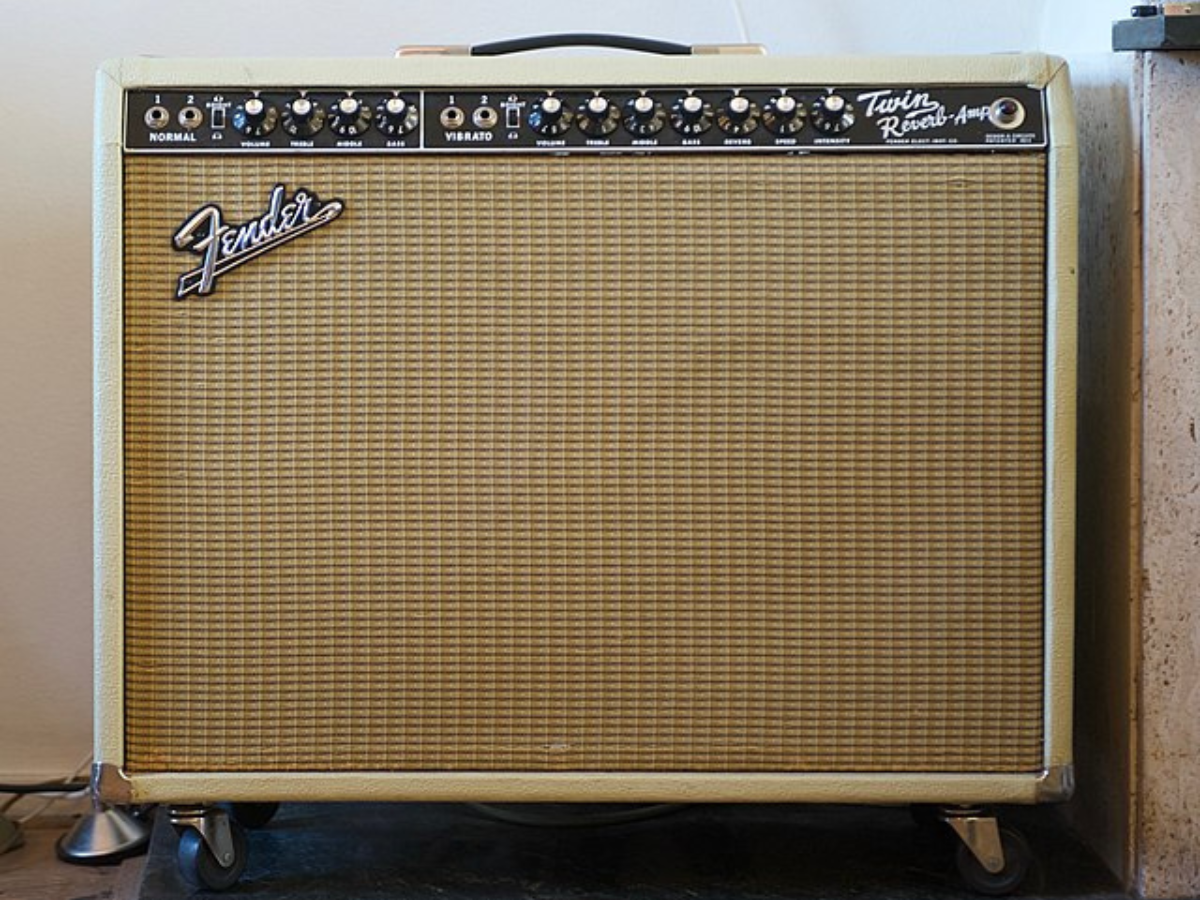
Fender Twin Reverb Guitar Amp
Fender’s Twin Reverb is probably the most famous guitar amp in terms of achieving a clean tone. Introduced during Fender’s “Blackface era” (during which amps featured black faceplates) in the 1960s, the Twin Reverb is revered for its amazing onboard spring reverb. You’ve probably heard this legendary amps tone if you’ve listened to enough music White Stripes, Stevie Ray Vaughan, or even B.B. King.
Although an original 1965 Fender Twin Reverb would run you about $3000-$5000, you can get your hands on a reissue of this classic for under $1950 on Sweetwater! This reissue is particularly exciting because of Fender’s dedication to recreating the mid-’60s technical setup that players originally fell in love with.
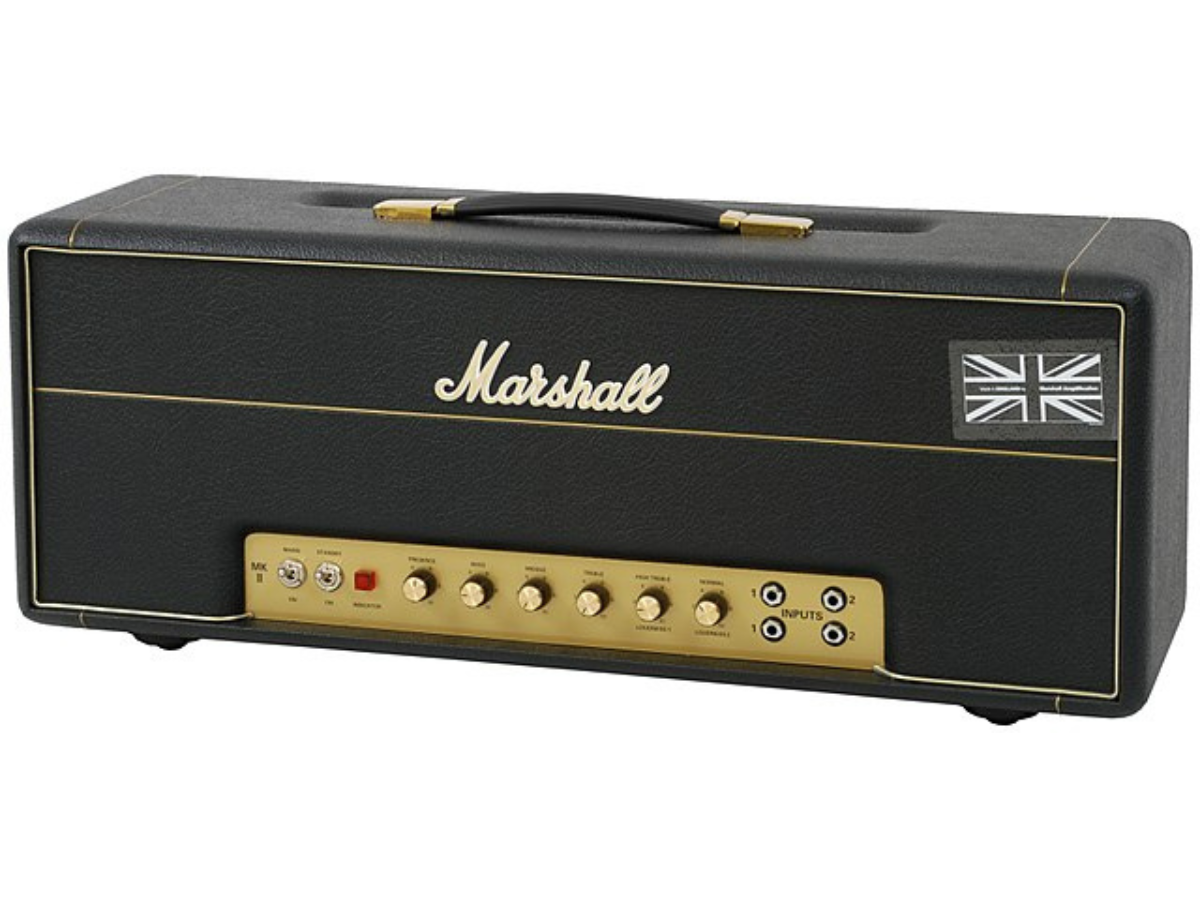
Marshall 1959 Super Lead 100 Watt Plexi
Contrary to what its title may suggest, the Marshall 1959 was actually introduced in 1965 and was produced until 1981. This guitar amp’s conception was a result of The Who’s legendary guitarist, Pete Townshend requested that Marshall make a 100 watt amplifier. The 100 watt Plexi edition of the Marshall 1959 is famous for being the quintessential rock guitar amp, and was also used by both Eric Clapton and Jimi Hendrix.
If you are seeking a monstrous amount of volume and the ultimate rock tone, you can find a hand-wired reissue of the Marshall 1959 on Sweetwater.
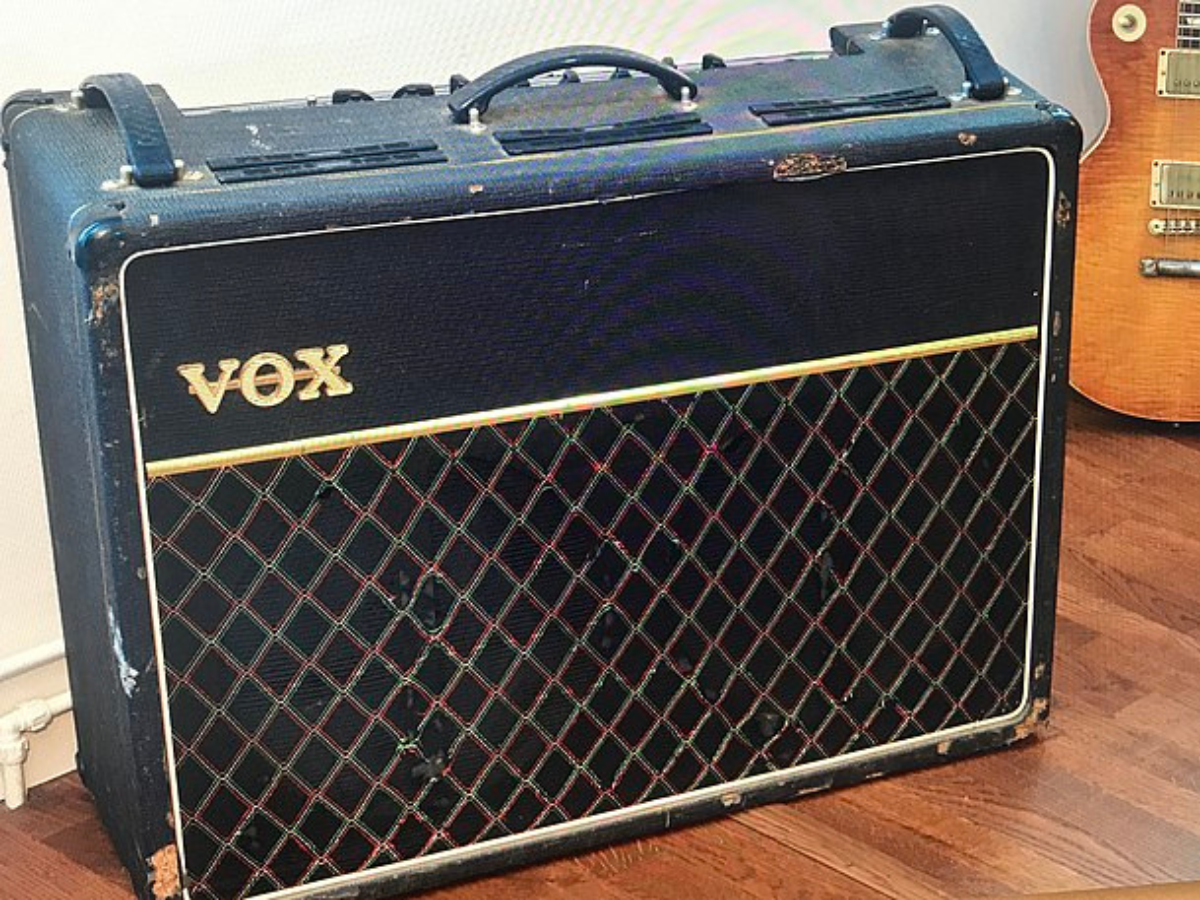
Vox AC30 Guitar Amp
According to legend, the 30 watt version of Vox’s AC line resulted from Cliff Richard’s guitarist, Hank Marvin requesting an amp that was loud enough to be heard over the cacophony of screaming showgoers. Vox has released several technically different models of the AC30 since its debut in 1959. Its cabinet design was updated in 1960 to what you see in the image above, and essentially hasn’t changed since. This guitar amp has been favored by guitar legends such as George Harrison, John Lennon, Brian May, and Bill Wyman, and continues to be a popular pick for guitarists.
You can find great deals on various Vox AC30 models on Sweetwater! Newer versions of this amp are technically reissues, but still perform just as well.
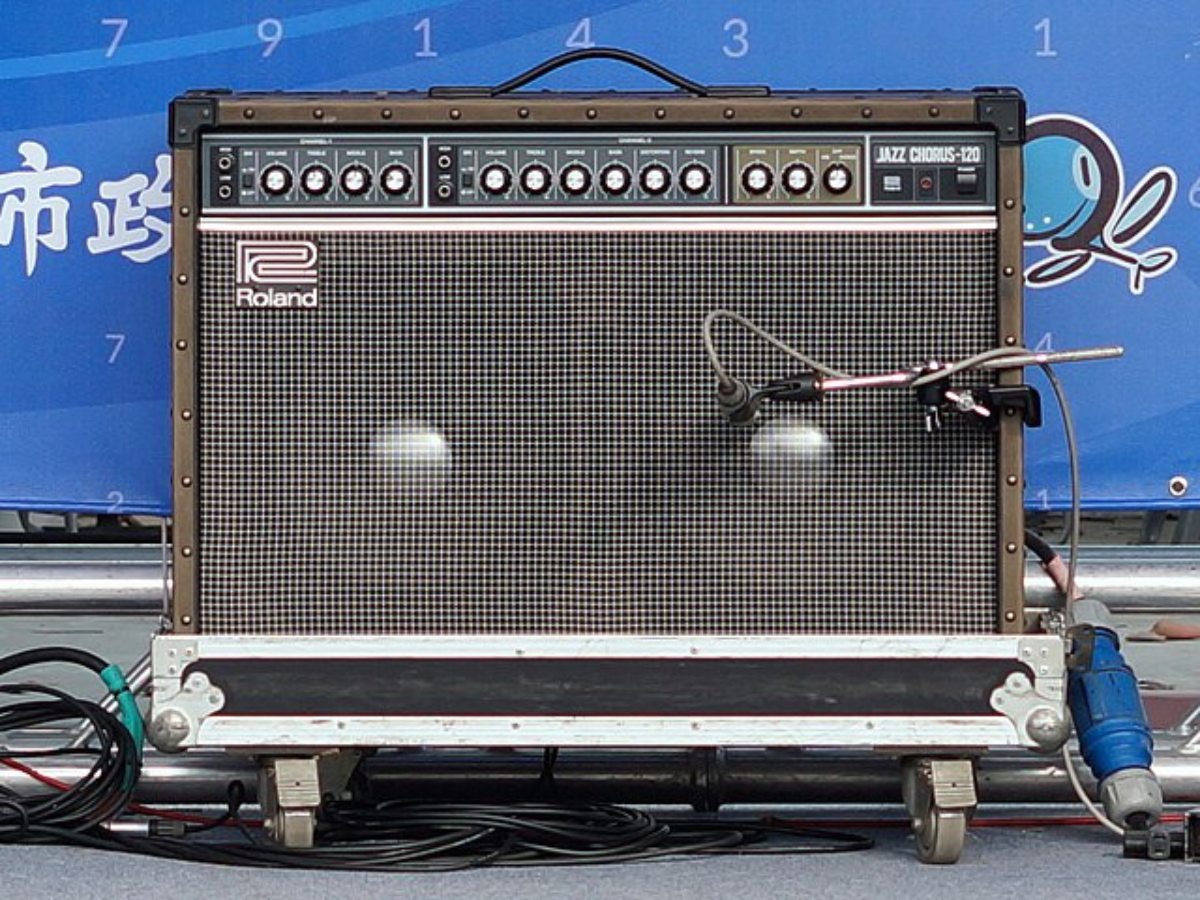
Roland JC-120 Guitar Amp
The Roland Jazz Chorus (JC) series probably contains the most versatile set of amplifiers on this list. The JC-120 got its name because of the chorus effect built into the guitar amp. However, this combination amp is most famous for its clean tones across varying genres. Having been favored by Andy Summers of The Police and Albert King, but also by Metallica guitarists James Hetfield and Kirk Hammett, this champ of an amp is suitable for any style of playing.
You can even find one for under $1250 on Sweetwater. Yes, this is a link to the original – no reissues on this one!
Excited to look at some new guitar amps? Find all kinds of great guitar gear deals over at Sweetwater.com.
For guitar lessons that teach you how to use effects like these, check out JamPlay.com! JamPlay has over 450 guitar courses from 120+ instructors, LIVE daily instruction, and online guitar lessons tailored to every skill level, music genre, and playing style. Click here to learn more.
Share this
Become a JamPlay member for unlimited access to 7000+ guitar lessons and 120+ artists and instructors. View membership plans ›
Related Posts
Trevor Gordon Hall's Fingerstyle Fretting Hand Mastery
Fingerstyle, synonymous with fingerpicking, is one of the most popular modern guitar techniques. Although the technique has been around for hundreds of years, the contemporary style was made globally popular by guitar pioneers like Merle Travis and Chet Atkins. And through the generations, the methods for learning and partaking in this tradition have become more and more refined.
In Trevor Gordon Hall’s JamPlay guitar course, Fingerstyle Fretting Hand Mastery, he aims to help you avoid getting stuck on some of the most common roadblocks you’ll encounter learning this style. Believe it or not, your fretting hand can be a stealthy culprit. Let’s dive in to mastering your fingerstyle fretting hand!
About the Course:
In the world of fingerstyle guitar, having flexibility, strength, and an expressive touch in your fretting hand is paramount to performing. So, you’ll start this course by learning best ways to stretch vertically and horizontally to notes. This will be an important skill to hone when you start learning essential chord voicings. Then, Trevor will walk you through some key strength exercises so you can build the stamina you’ll need to carry out full performances, especially on an acoustic guitar. Lastly, Trevor will fill you in on how to play with force while maintaining an expressive touch. Playing expressively is how you keep an audience engaged and emotionally invested in a song.
Try it out!
Here’s an example of an expressive technique you’ll be working on with Trevor Gordon Hall. When playing natural harmonics, it’s important to stay nimble with your fretting hand. Otherwise you’ll end up getting a bad tone, or inadvertently dampening the notes when they should be ringing out.
For more fingerstyle guitar lessons and an ever-growing library of Song Lessons, check out JamPlay.com! JamPlay has over 450 guitar courses from 120+ instructors, and online guitar lessons tailored to every skill level, music genre, and playing style. Click here to learn more.
Share this
Become a JamPlay member for unlimited access to 7000+ guitar lessons and 120+ artists and instructors. View membership plans ›
Related Posts
July 14, 2022

